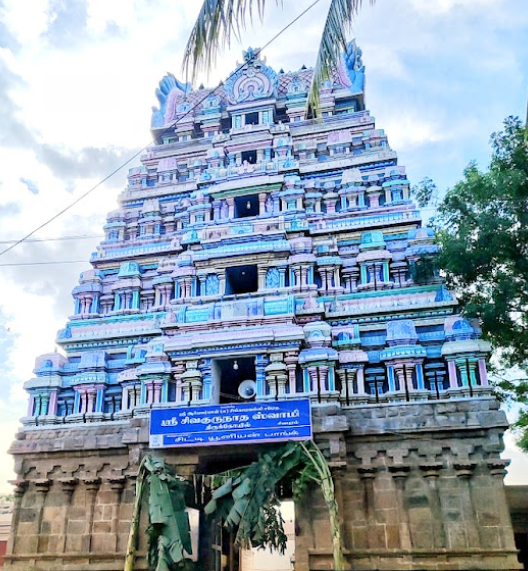It is believed that a Shivalinga lies beneath the earth at this sacred site. Due to this belief, Saint Thirugnanasambandar, during his visit, performed Angapradakshinam (a form of worship where one rolls around the temple) to avoid letting his feet touch the ground while revering the Lord. The nearby Arisil river flows close to the temple, and the location where Gnanasambandar performed the Angapradakshinam is referred to as Arisil Thurai.
Additionally, Sage Pattinathar is depicted in a sitting posture at the nearby Vinayaka temple.
Sthala Puranam:
It is believed that Lord Vishnu, in the form of a white boar (referencing his Varaha avatar), worshipped Lord Shiva with lotus flowers. This event is depicted in murals on the temple walls and is mentioned by Appar in his Tevaram hymns.
The town of Sivapuram is believed to have countless Shiva Lingams buried beneath the ground, giving the town its name. Due to this belief, Thirugnanasambandar did not step on the ground when he visited. Instead, he performed Angapradakshinam (rolling in devotion) around the temple. Afterward, he went outside the town and sang his pathigam from a place near the Arasilar river, known as Swamigal Thurai. This tradition has made Angapradakshinam a favoured form of worship among devotees here.
The temple is also known by other names, such as Kuberapuri, Swetaranyam, and Bhukailasam.
According to legend, Ravana once went to Kailasam in an impure state. Nandi barred his entry, and despite Kubera—Ravana’s brother—speaking in Ravana’s favour, Nandi refused and cursed Kubera to be born on earth. Kubera incarnated as Dhanapati, a king, and worshipped at this temple, eventually regaining his position among the Devas. The Lingam Kubera prayed to is the presiding deity, Sivagurunathar, and a special Kubera puja is conducted on Deepavali day. Worshipping at this temple on Deepavali is believed to bring prosperity and financial well-being.
The Lord Shiva here is a Swayambhu murti (self-manifested deity).
A unique aspect of this temple is the shrine dedicated to Bhairavar. His dog companion is depicted with its left ear lifted, symbolising attentiveness to devotees' prayers, passing them on to Bhairavar. Another rare feature is the depiction of Rahu beneath Dakshinamurti’s feet, instead of the usual Muyalagan—a highly unusual representation in temple iconography.
Other notable devotees who worshipped here include Agni, Ravana, Appar, Thirugnanasambandar, and Pattinathar. Arunagirinathar also sang Tiruppugazh in praise of this temple. Devotees observe fasting on 11 consecutive Fridays and perform special archanas to Goddess Periyanayaki to pray for children.
The temple, in its present form, dates back to the later Chola period.
One of the most intriguing events in the temple's history is the idol theft of 1953. In 1951, a farmer discovered some idols in his field, which were handed over to authorities. They commissioned a sthapathi (sculptor) to repair and return the idols to the temple. However, it was later revealed that the original idols, including a magnificent Nataraja, had been replaced with fakes. The originals were smuggled to the USA. After years of investigation, the ASI managed to recover the stolen idols in 1987, and they are now stored in the vaults of the Thyagaraja Temple in Tiruvarur (or, according to some reports, in the Kapaleeswarar Temple in Chennai).
Administration History :
The temple's administration history reflects a rich legacy spanning several dynasties. It is believed that the original structure predates the 7th century, as evidenced by hymns sung by Thirugnanasambandar and Thirunavukkarasu Swamigal. During the Later Chola period, the temple was reconstructed into a stone edifice. Subsequently, the Thanjavur Nayaks extended its features and significance. The Nattukottai Nagarathars have been responsible for the temple's upkeep and administration over the years. This continuity of care has helped preserve the temple's spiritual and architectural heritage.
